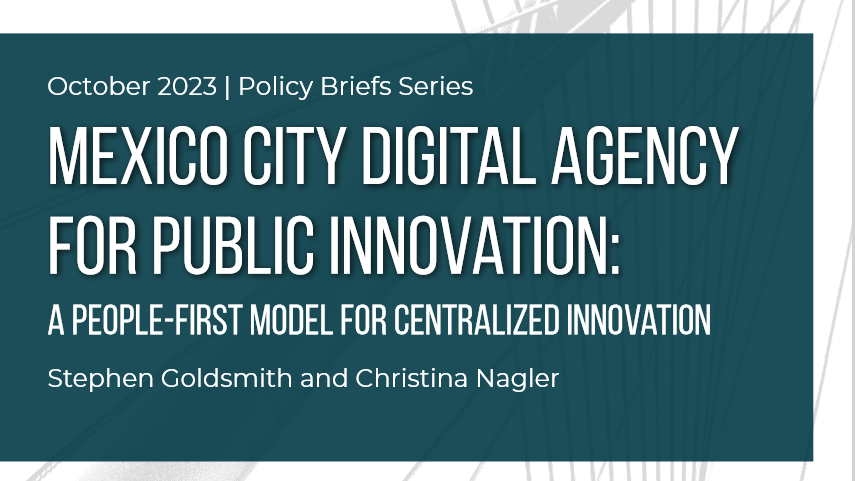- August 31, 2016
- The Responsive City
This article originally appeared in the Journal of Law & Public Affairs, Volume I, Issue I, Summer 2016.
Introduction: Trust in Local Government
“Local” matters now as never before. Prominent voices across the academic and policy communities are drawing attention to role municipal government plays in shaping better outcomes for residents of urban communities. Recent groundbreaking research by Stanford economist Raj Chetty and his colleagues on inequality in cities emphasizes the importance a person’s zip code plays in shaping his or her future economic opportunity.[1] Various scholars, including Bruce Katz of the Brookings Institution, Jennifer Bradley of the Aspen Institute, and Benjamin Barber of the Global Parliament of Mayors rightly point to cities as the most promising vehicles of change on the most intractable problems facing civil society today.[2] So what’s getting in their way?
Municipal officials take pride in the fact that trust in local government consistently ranks higher than state or federal governments.[3] But a closer examination of trust metrics across all levels of government should raise some alarm. The Edelman Trust Barometer, a global index of civilian trust across a range of institutions, reports that trust in government overall generally hovers at 40%, a level substantially lower than the NGO, business, and media categories.[4]
What’s more, the trust gap between elites and masses is growing.[5] The “informed public” – educated individuals who sit at the top of the income distribution – reported much higher levels of trust in government than their peers in the “mass population.”[6] Of the 25 countries in the survey, the United States reported the largest gap between the two groups.[7]
One test of a truly responsive city could be whether every resident can get a rideshare in his own neighborhood, start his own small business, or qualify to practice his trade: chances are that those whose access is most limited by these obstacles are those who trust in government the least. The attributes of higher levels of government that account for the public's mistrust – the polemical rhetoric and inability to act too often characteristic of federal government – are less pronounced in municipalities. Local governments are in a prime position to drive change, but change is difficult when a trust differential persists. Given these challenges and limited resources, we ought to turn our attention to closing the trust deficit by removing the barriers to government responsiveness.
Progressive Government is Obsolete
When government fails to be effective at the local level, it is often not due to a toxic political climate. Rather, what prevents local government from standing out as the bright spot in American democracy are the calcified bureaucratic structures and outdated rules that plague the system. We inherited this structure of local government from the early 20th century when Progressive reformers successfully advocated for a rule-based approach to public sector management.[8] The reformers responded to the cronyism and wastefulness, iconized by the corrupt ward politics of the notorious Boss Tweed in New York City, that were rampant in cities across the nation at the time.[9] The resulting controls were seen then as a means to create stability with a clear set of protocols for who could be hired, how contracts were awarded, and what behavior was allowable.[10]
These efforts pushed city hall to redouble its focus on a hierarchical method of manufacturing good government, inspired by the efficiency of the division of labor on the Model T assembly line.[11] “Performance,” in this model, was based on obeisance to the rote.[12] But over time, new challenges unfold. The very rules that once enhanced accountability and efficiency now stifle the creativity of public sector workers and limit public investments from creating opportunities for citizens.
In the past two decades, “network governance” has come to replace “government” as the predominant approach elected officials take to deliver public services.[13] The barriers between the private, nonprofit, and public sectors are becoming more permeable, and governance allows leaders to consider the network of once-isolated resources in their sphere of influence. As a result, government – local government especially – is finding itself moving away from its exclusive role as a direct service provider to a hybrid manager of the public good, producing value by leveraging a variety of partners and third parties. This approach has seen many successes in better serving communities, but its potential is limited by a litany of outdated rules that can inadvertently function as inhibitors of municipal innovation.
Theory of Change: the Strategic Triangle
To be effective, city government needs to be trusted. To be trusted, the city needs to be responsive to citizens’ needs. This proves difficult in a Weberian bureaucratic model.[14] For a theory of the impact of innovation on public trust, we look first to Professor Mark Moore, a colleague of mine at the Harvard Kennedy School. He proposes the “strategic triangle” as a comprehensive framework to help government managers decide how to commit their organizations to a certain course of action in the interest of maximizing public value:
“The image [of the strategic triangle] focuses managerial attention on the three key questions managers must answer in testing the adequacy of their vision of organizational purpose: whether purpose is publicly valuable, whether it will be politically and legally supported, and whether it is administratively and operationally feasible.”[15]
One point on the triangle requires leaders to define the stakes: what public value does the organization want to produce?[16] Another is to be clear about operational capabilities by making pragmatic calculations of what is feasible.[17] These points require evidence that the targeted outcomes of a given action are in fact valuable and effective, and that their costs can be reasonably anticipated and sustained. On Moore’s third point, legitimacy and support, the potential of public value is capped.[18] This refers to the legal and political climate that make actions either viable or not. Too often, good ideas are not implemented because they may be illegal due to misguided administrative constraints. Civil service restrictions, union contracts, and rule-based work systems all elevate legal procedure over solving problems. A revitalized interest in innovation in government is demonstrating just what is possible, but improbable so long as the current legal structure remains in place.
Rules draw a bright line between allowable and unallowable activity and are therefore easily enforceable. Standards instead articulate a policy goal: their enforceability is left up to the discretion of those charged with protecting the public good. Progressive reformers created rules to chart the course of government in a moral vacuum of good standards. But times have changed. New forms of responsive governance and data-smart decision-making can create a standard-based regulatory regime that perpetuates not only the rule, but embodies the spirit of the law.
Regulation 2.0
As part of the recent Regulatory Reform in the 21st Century City project at the Harvard Kennedy School, Nick Grossman offers a roadmap for regulatory innovation using the “Internet way.”[19] He defines the rules developed in the 19th and 20th centuries as the “1.0” approach to regulation.[20] These regulatory strategies “took an ‘up-front permission’ approach, based on central licensing and permitting as a prerequisite for acting” and include such bureaucratic procedures as small business permitting, background checks, and pet registration.[21] They are slow by design, intending to promote policy goals by precluding problems that might arise later on.
A better regulatory system, Grossman argues, transitions from the ethos of permission to “Regulation 2.0,” an accountability model based on adept use of data.[22] It is with Regulation 2.0 that companies such as eBay achieve accountability without a hardline regulation handed down by government. Users may act freely but are held to account for the data they produce. This model accommodates quick scaling, which is crucial for digital platforms that may have millions of active users and are constantly adding more. For this reason, Regulation 2.0 is also the strategy employed by Internet governing bodies, which use a standards-based approach. On this point, Grossman writes:
Standards-setting is a negotiation among many stakeholders, not a command-and-control process, and it’s more art than science. But, once adopted, the existence of these standards enables broad innovation, since all of the players (app developers, infrastructure builders, regulators, etc.) know the terms of engagement and can build freely, without needing to seek permission first.[23]
The Internet is a decentralized but coherent structure that supports an array of interconnected but distinct platforms – not unlike a city. Just look to the array of domains – commercial (.com), nonprofit (.org), and governmental (.gov) – that operate, much like in a city, on its shared infrastructure. Grossman’s central contention is that cities should be regulated, like the Internet, with a network governance approach.[24] Regulatory reform “the Internet way” is focused on using data to drive action instead of circumscribing action with rules, and accommodates government’s obligation to maintain standards while supporting innovation.[25] Consider the following examples of issues inherent to regulation 1.0 and their potential 2.0 remedies.
Public Workers: Rule Enforcers or Solution Providers?
Municipal health and sanitation officials abide by strict codes that leave frontline workers little room for nuanced responses to situations that arise on the job. Take restaurant inspections. The sheer volume of food establishments in a city—Chicago, for instance, has more than 15,000—makes proper attention to each difficult.[26] As a result, small business owners are often fined for violations that do not present substantive health or safety risks. If the temperature of a restaurant’s cheese stock is even a sliver above the government-mandated level, an inspector writes a ticket, regardless of whether the cheese had just been delivered or was just about to be sold. Sushi chefs who forego gloves in order to prepare sushi in the culturally sanctioned (and exceptionally sanitary) way face a similar compliance risk.[27] Such pains are exceptions rather than the norm, but to deliver such a burden to those whom public officials should be enabling is irresponsible given the alternatives in plain sight.
Imagine an alternative scenario: an inspector finds a nominal violation but determines no health concern is at stake. She decides not to write a ticket, but flags this decision as an exception in a tablet-based software. The data trail creates a record that her manager can instantly view to determine whether the use of discretion was appropriate. The concept of such “documented exceptions,” which was developed in the context of regulatory reform in child welfare, refers to cases in which a rule is not enforced but “the worker can explain and substantiate the reason for deviation.”[28] The idea, which holds as true in health inspections as it does in social work, is that the standards to which worker’s behavior is held “must be both learned and elaborated in the course of practice.”[29] In this model, the public employees who exercise discretion inappropriately can be weeded out with data analytics – but only if the regulatory climate allows it.
Regulating for Results
Back in 1995 when I was mayor of Indianapolis, a taxi cartel enjoyed exclusive rights to the city’s 392 only taxi licenses – and wanted to keep it that way.[30] The incumbent companies argued that limiting the number of licenses was the only way to ensure that only safe cars and safe drivers were on the road. But other, more direct standards for drivers and vehicles could be used to achieve the same result without artificially limiting the number of providers, so I pushed to both eliminate the caps and simplify safety regulations. As a result, the number of taxi companies, most owned by minorities or by women, nearly doubled. Fares dropped significantly, and the number of customer complaints went down.[31]
When Uber began infiltrating American cities five years ago, it relied on innovative technologies to disrupt an industry that had relied long relied on its cartel status.[32] The structure of the business, relying as it does on smartphone technology, mostly worked around, not through, city hall. Old regulatory approaches cannot easily adapt to new service models, illustrated by the conflict between the ridesharing “platform model” and a reactive regulatory environment.[33] Today, municipalities are racing to determine how they will confront the challenge that Uber is creating for government’s traditional approach to ensuring transit standards. Some are doing better than others. Los Angeles, for instance, is taking on the role of “mobility manager” by forming partnerships with companies working in the sharing economy.[34] To return to Moore’s strategic triangle, Los Angeles shifted out of its reactive role as regulator by changing the the legal environment in the transportation marketplace, generating a return of public value in the form of enhanced citizen mobility.
A remark on trust and social equity
Municipal policies and practices that have existed unexamined for decades can have inequality baked into their core. The New York Times recently published an editorial titled “A Modern System of Debtor Prisons,” which lambasts state and local courts for punishing those who commit minor offenses with severe financial penalties that could push them into poverty.[35] A similar 2015 report in the Los Angeles Times found that the delivery of basic city services, such as filling a pothole, disproportionately favored those in wealthier neighborhoods.[36] Even snow removal becomes a social concern when parking restrictions are disproportionately enforced in low-income areas, leaving poorer residents to pay for towed cars more often than their wealthier neighbors.[37]
While these findings are troubling, they also signal nascent progress. That these determinations can be made is a testament to the way that data is getting better and transparency is increasing in government. As we begin to better quantify the results of policies, we can become more responsive in making adjustments—whether to their authorizing language or to the way they are applied.
Conclusion
The Edelman Trust Barometer helps us not only understand the problem, but the solution as well. The report points to the widespread shift of influence from “authority” to the mass public.[38] This situation is hardly surprising and parallels the growth of the 2.0 regulatory model – think Amazon product ratings or Yelp reviews. There is no dearth of technological tools and innovative programs aimed at amplifying community voices. But for these tools to fully realize their potential and deliver improvements to government services and community engagement, they need to be accompanied by a concomitant shift in the structure local government – one that encourages innovation rather than stifling it.
Local government is not broken, just burdened. The obsolete rules and regulations discussed here make the conceptualization of alternatives difficult, creating tunnel vision for what is possible. Creating new standards that respond to these conditions takes imagination, which, broadly writ, means the ability to come up with something new and unique. Good data provide a way to see cities, not as 20th century bureaucrats intended them to be, but in the present reality. Open data and analytics enhance the effectiveness of social services and give a better understanding of whether a public service is being delivered equitably and for whom it is being delivered. In order to restore trust and amplify social impact, responsive public officials today must take these insights to heart to imagine the city not as it was, but what it could be.
[1] Raj Chetty et al., The Association Between Income and Life Expectancy in the United States, 2001-2004, 315 JAMA 1750, 1750-66 (2016).
[2] See generally Bruce Katz & Jennifer Bradley, The Metropolitan Revolution: How Cities and Metros are Fixing Our Broken Politics and Fragile Economy (2014); Benjamin Barber, If Mayors Ruled the World: Dysfunctional Nations, Rising Cities (2013).
[3] Justin McCarthy, Americans Still Trust Local Government More Than State, Gallup Poll (Sept. 22, 2014), available at http://www.gallup.com/poll/176846/americans-trust-local-government-state....
[4] Edelman Trust Barometer: 2016 Executive Summary, Edelman, Inc. (2016), available at http://www.edelman.com/insights/intellectual-property/2016-edelman-trust... [hereinafter Edelman Trust Barometer 2016].
[5] Id. at 2-3.
[6] See id. at 2 (distinguishing “informed public” by the following four criteria: ages 25-64, college educated, in top 25% of household income per age group, and reporting significant media consumption and engagement in business news and public policy).
[7] Id. at 2-3.
[8] Kenneth Finegold, Traditional Reform, Municipal Populism, and Progressivism: Challenges to Machine Politics in Early-Twentieth-Century New York City, 31 Urban Aff. Rev.1, 20-42 (1995).
[9] Id.
[10] Id.
[11] Joseph J. Schiele & Clifford P. McCue, Lean Thinking and its Implications for Public Procurement: Moving Forward with Assessment and Implementation, 11 J. Pub. Procurement 206, 239 (2011).
[12] Id.
[13] See generally Stephen Goldsmith & William Eggers, Governing by Network: The New Shape of the Public Sector (2004).
[14] See generally James March & Herbert Simon, Organizations (2d. ed. 1956).
[15] Mark Moore, Creating Public Value: Strategic Management in Government 22 (1995).
[16] Id.
[17] Id.
[18] Id.
[19] Nick Grossman, Regulation, The Internet Way: A Data-First Model for Establishing Trust, Safety, and Security, Data-Smart City Solutions (Apr. 8, 2015), http://datasmart.ash.harvard.edu/news/article/white-paper-regulation-the....
[20] Id.
[21] Id.
[22] Id.
[23] Id.
[24] Id.
[25] Id.
[26] Sean Thornton, Delivering Faster Results with Food Inspection Forecasting, Data-Smart City Solutions (May 19, 2015), http://datasmart.ash.harvard.edu/news/article/delivering-faster-results-....
[27]See generally Glen Collins, Even the A Students Sometimes Break Health Rules, N.Y. Times (Feb. 28, 2012), http://www.nytimes.com/2012/02/29/dining/new-york-city-restaurants-skirt... (providing an examination of the way chefs feel encumbered by regulations that leave little room for time-tested culinary practices).
[28] Kathleen G. Noonan et al, Legal Accountability in the Service-Based Welfare State: Lessons from Child Welfare Reform, 34 Law & Soc. Inquiry 523, 536 (2009).
[29] Id. at 537.
[30] See Steven Hayward, Slashing Through the Regulation Thicket, Hoover Inst. Pol’y Rev. (Nov. 1, 1998), http://www.hoover.org/research/slashing-through-regulation-thicket (describing Indianapolis Mayor Goldsmith’s to overcome special interests and bureaucratic structures, particularly within taxicab regulation).
[31] William Eggers & John O’Leary, Revolution at the Roots: Making Our Government Smaller, Better, and Closer to Home 284 (1995).
[32] Ramon Casadesus-Masanell et al., Uber and the Taxi Economy, Harvard Bus. Sch. Case (Mar. 2015).
[33] Stephen Goldsmith, A Gathering Revolution in Regulation, Governing (Aug. 19, 2015) http://www.governing.com/blogs/bfc/gov-cities-regulation-revolution-tech....
[34] See Stephen Goldsmith, L.A.'s Testing Ground for Transportation Efficiency, Governing (Mar. 16, 2016) http://www.governing.com/blogs/bfc/gov-los-angeles-transportation-effici... (“These partnerships are creating a growing awareness of the range of possibilities posed by a city’s traffic and population movement data, including more surgical policy interventions and better outcome evaluation.”).
[35] James Bennet et al., A Modern System of Debtor Prisons, N.Y. Times (Mar. 26, 2016), http://www.nytimes.com/2016/03/28/opinion/a-modern-system-of-debtor-pris....
[36] Ben Poston & Peter Jamison, Inequity is 'baked in' when it comes to L.A. city services; where you live matters, L.A. Times (Aug. 28, 2015), http://www.latimes.com/local/la-me-adv-city-service-20150829-story.html (“The findings parallel those in a Times report earlier this month, which found that city crews respond to complaints of illegally dumped refuse at dramatically different rates in many of the city's 114 neighborhoods. And poorer areas generally received worse service than wealthier ones.”).
[37] In the process of implementing a citywide race equity plan in St. Paul, Minnesota, the Government Alliance on Race Equity (GARE) in partnership with the city found that snow removal was disproportionately affecting St. Paul’s racial minorities. The city has since changed its processes and implemented an accountability strategy based on better organized collection and visualization of street sensor and weather data. Interview with Mayor of St. Paul, Minnesota (2015).
[38] Edelman Trust Barometer 2016, supra note 4, at 9.


 Craig Campbell is the Assistant Director for Policy & Operations for the NYC Mayor’s Office of Data Analytics (MODA). Prior to working for the City of New York, Craig researched trends in municipal data analytics, supporting several national policy networks and research programs at the Ash Center for Democratic Governance and Innovation at Harvard Kennedy School. Craig holds a degree in architecture and mathematics from Amherst College.
Craig Campbell is the Assistant Director for Policy & Operations for the NYC Mayor’s Office of Data Analytics (MODA). Prior to working for the City of New York, Craig researched trends in municipal data analytics, supporting several national policy networks and research programs at the Ash Center for Democratic Governance and Innovation at Harvard Kennedy School. Craig holds a degree in architecture and mathematics from Amherst College.
 Stephen Goldsmith is the Derek Bok Professor of the Practice of Urban Policy at the Harvard Kennedy School and the
Stephen Goldsmith is the Derek Bok Professor of the Practice of Urban Policy at the Harvard Kennedy School and the 

